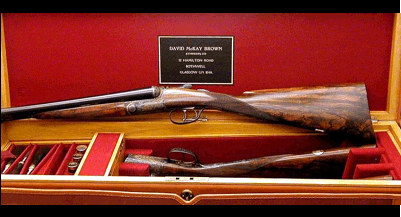Anyone who shoots a 16-gauge shotgun should send Doug Oliver a big cigar.
As founder of the 16 Gauge Society, Doug has been keeper of the flame for a shotgun orphaned by the industry.
Over the years marketing decisions within the shotgun industry have relegated the 16 gauge from the second-most popular shotgun to an icon of perfection among a small band of bird shooters. They marketed the smaller 20-gauge rival, despite the superior ballistics of the 16 gauge. At the same time, the 12 gauge has been gentrified from its bruiser, meat-market heritage to a relatively comfortable, all-purpose shotgun.
The world of tournament shooting has also conspired against the 16 gauge. Simply put, there are no 16-gauge competitions in major clay-shooting events – depriving the 16 gauge of the credibility and high-profile marketing opportunities to sustain a thriving market.
Still, the perseverance of devoted 16-gauge shooters has kept the shotgun alive. And you could easily make the case that Doug has emerged as the voice of the 16-gauge shotgun community.
“If I were trapped on a desert island, I would want the 16 gauge, because it won’t beat you up and it kills birds without killing you,” Doug said.
Maybe it’s a confluence of happy circumstances that Doug, who owns a graphic-design firm in Bell Canyon, California, fell in love with 16-gauge shotguns to the extent that he started the 16 Gauge Society web site.
He fondly recalls shooting 16-gauge shotguns as a kid in Newton, Kansas with his father.
“From the age of 10, I started hitting birds, and I became joined at the hip during bird season with my father. We’d hunt quail, pheasant, doves…,” he said.
During that period, he started out with a .410, and passed through a 16 gauge on his way to a 12 gauge. He remembered liking the 16 gauge, although for the bigger part of his life he shot 12 and 20 gauge.
“The 16 gauge is absolutely the perfect shotgun,” he explains. “It has a perfect load for wingshooting. Plus a 16 gauge will typically be a pound lighter than a 12 gauge if you’re carrying it all day in the field. The 16 gauge shoots like a 12 gauge but carries like a 20 gauge. It’s a great gun.”
When Doug turned 50, for his midlife crisis instead of a Porsche he bought himself a shotgun. It was a 16-gauge F.A.I.R. Rizzini over/under. It was a better gun than he had known at that point.
On a flight from Los Angeles to New York, he had been reading an article in Double Gun Journal about dove hunting in Argentina. Until that point he had every intention of buying a 20 or 28 Beretta, but the article deflected him to the 16-gauge F.A.I.R. Razzing.
Doug found himself smitten by the lovely 16 gauge. In doing his “homework” for that 16-gauge F.A.I.R. Rizini he realized “that 16 gauge was a stepchild,” he explained. “Information at the time was so hard to dig out and that’s where the 16 Gauge Society web site came in. I though I’d just design and throw up 16 gauge web site and maybe sell a couple of hats. The project itself was fun and informative.”
After a few months of hard work, the 16 Gauge Society web site went up in 2002 at http://www.16ga.com.
It now has approximately 1,500 members of the 16 Gauge Society, plus another 2,400 people who frequent the site’s forum which serves as a clearing house of information for everything 16 gauge. Over 60,000 posts have been recorded on the site.
As Doug relates about the forum “You can throw a question out about a gun and 10 guys will answer you – civilly.”
There is a one-time, lifetime $25 membership to the 16 Gauge Society. But for Doug, the organization “is not a moneymaker. It’s a passion.”
Last autumn, one of the members of the 16 Gauge Society organized a pheasant shoot in North Dakota. A dozen or so members met for the first time there. “It was fun, everybody got pheasants,” he said. “A good time was had by all.”
In a way, that was a trip back to the good old days of 16-gauge hunting.
Doug is an active 16-gauge shooter. Of the 10 shotguns he currently owns, four of them are 16 gauge. He still has that F.A.I.R. Rizzini, in addition to a 1959 Beretta Silverhawk and two Browning Sweet 16 A-5s.
He recalled that when he began hunting there were a lot of 16-gauge shotguns on the market. Winchester Model 12s, Ithaca and Remington pumps, and the Browning Sweet 16 A-5s dominated the market, alongside a smattering of Fox, Parker and L.C. Smith doubles.
Although many a young hunter was started in the field with a 16 gauge, by the late 1950s and early 1960s, the 20 gauge, and later the 20-gauge 3-inch magnum, simply buried the 16 gauge shotgun in the U.S.
Doug now thinks that the 16 gauge is experiencing a renaissance. “After a 50-year decline in popularity, the sixteen is making a well-deserved comeback. And in a number of production lines, too.”
Today, although sometimes difficult to find, the industry still offers the standard and high-velocity lead and non-toxic loads from all major manufacturers. “Yet even though this situation has improved in the last few years, most serious 16-gauge shooters custom hand load their own shells. This is true of many shooters regardless of gauge,” Doug observed.
Affordable 16-gauge shotguns are available from a number of manufacturers including Griffin & Howe, Arietta, A. H. Fox, Browning, Connecticut Shotgun Manufacturing Company’s Model 21, Cortona, Arietta, Dean, Grulla, Stoeger and a handful of others.
And of course, there are also thousands of used 16-gauge shotguns in search of a new home.
Noe Roland is a frequent contributor to Shotgun Life. You can reach him at letters@shotgunlife.com.
Useful resources:
http://www.arrietashotguns.com/
http://www.connecticutshotgun.com/ahfox1.html
http://www.connecticutshotgun.com/model21.html
http://www.cortonashotguns.com/
http://www.grullaarmas.com/es/
http://www.stoegerindustries.com/
{loadposition signup}






















